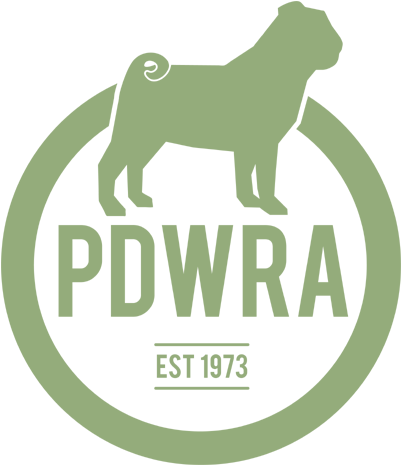by Yasmin | 7 Aug, 2025 | Blog, Pug Health
Written by Helen McKee
PDWRA Veterinary Advisor
I am sure all of you, and anyone who has had a pug, is familiar with the term ‘BOAS’. It stands for Brachycephalic Obstructive Airway Syndrome’
It is a large topic and there is much to discuss about the condition, but hopefully I will keep it concise and in a way that can be understood. It’s also a controversial subject due to the impact it has on a dog’s (pug’s) health and welfare.
It’s a condition that has been created by the breeding of dogs so they have little or no snout.
This has then resulted in all the soft tissues at the back of the throat being squashed into a smaller space. The nose structure, both externally and internally, can be abnormal, but more importantly (for pugs), the soft palate (and tongue) are too large for the size of a pug’s head and throat.
The most significant part (for a pug) is an excessively long soft palate, which obstructs the airflow through the larynx (access at back of throat to lungs) into the trachea. This leads to a rattling noise or what is known as ‘stertor’, and less air being able to reach the lungs. This affects a pug’s ability to exercise (exercise intolerance) and is exacerbated by carrying any excess weight, particularly because pugs carry extra weight around their necks.
This is why the condition is controversial; we have bred a dog that can’t breathe properly, which is a welfare issue. In the Netherlands it is now illegal to breed a dog without a certain length of snout.
The condition can vary from mild to severe, with extreme cases fainting (apnoea) due to lack of oxygen. The sooner this is addressed, the better, in order to prevent secondary problems developing which cause further breathing issues.
Secondary changes can occur when the obstruction of the soft palate is left without treatment (chronic). Because the airway is blocked by the tissue, it creates a negative pressure at the back of the throat causing the larynx to collapse. With time, the laryngeal tissues become damaged and soft. The negative pressure can also cause the tonsils to evert out of their crypts, and the so-called laryngeal saccules to do likewise. These everted structures then cause further obstruction in the airway, which becomes a vicious cycle.
Dogs who have these secondary changes make a different noise, ‘stridor’, which is more like a wheeze rather than a rattle.
Another condition which results from the long-term negative pressure caused by the obstructive long soft palate, is gastric reflux. The sphincter at the top of the stomach gradually becomes loose due to this negative pressure, resulting in gastric reflux. Signs of reflux are stretching out of neck, licking lips and regurgitation.
This can become a potentially life-threatening condition, especially when a pug is anaesthetized. Material can become sucked (aspirated) into the lungs, a condition known as aspiration pneumonia. For this reason, all brachycephalic dogs should be given the medication ‘Omeprazole’ prior to a general anaesthetic.
The treatment for BOAS is surgery. If there are no secondary changes, BOAS surgery tends to involve the reduction of the soft palate and widening of narrowed (stenotic) nares. In my opinion, and in fact mentioned by Dr Rowena Packer (an expert in BOAS) in the book ‘Health and Welfare of Brachycephalic Companion Animals’, widening of a pug’s nostrils is rarely a cause of BOAS.
Quoting Dr Packer :- “Previously, stenotic nares were thought to be of paramount importance, and early treatment was advised to open the nostrils….. Recent work from the Cambridge BOAS Research Group shows that the nostrils in the French Bulldog are of particular importance (not pugs). It is worth noting that we have seen mature dogs with no BOAS-related respiratory signs yet with severely stenotic nostrils.”
This is certainly my experience; I have rarely seen narrowed nostrils in pugs causing breathing problems, and I personally feel widening a dog’s nostrils has become a bit of a trend without assessing if it’s actually causing a clinical problem.
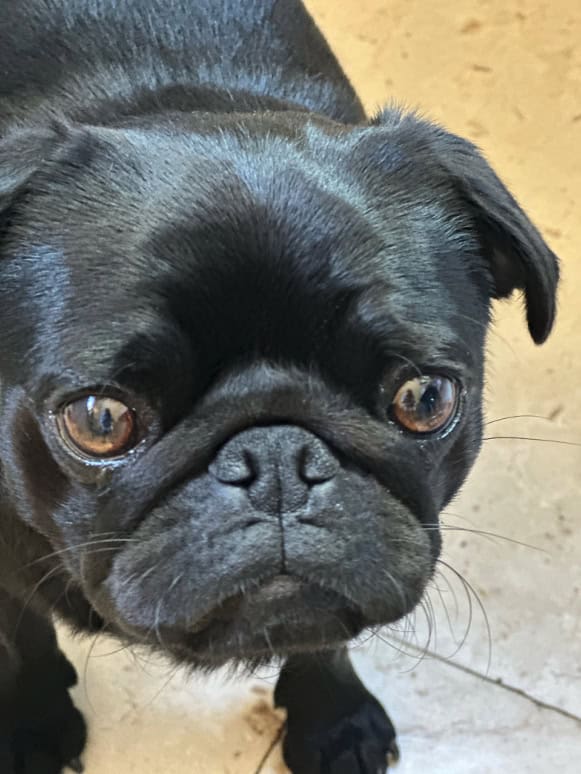
This is a photo of our rescue pug Molly, with her significantly stenotic nostrils, however she runs 7 miles daily and breathes comfortably.
If a dog’s mouth breathes when at rest, then this indicates they are unable to breathe through their nose. However, widening the nostrils may not resolve the issue, as often there are abnormalities in the nasal structures (turbinates) due to the extremely shorted muzzle, which compromise and block airflow through the nose.
Although BOAS surgery is generally straight forward when there are no secondary changes, it is best carried out by a veterinary surgeon with experience / extra qualifications (Specialist or an Advanced Practitioner in Surgery). Swelling can occur at the back of the throat immediately post-operatively, which needs to be managed carefully. When there are secondary changes, the surgery carries a greater risk of complications, including death.
It used to be the case that surgeons would remove the laryngeal structures that had everted and were blocking the access to the windpipe (tonsils, laryngeal saccules), however, recently specialists have been removing the soft palate tissue only, as this carries less risk of bleeding and swelling post operatively, and it has been found these structures may go back into their natural position once the ongoing negative pressure is removed.
These dogs need to have close management post-operatively to watch for any signs of swelling/laryngeal collapses causing breathing difficulties. They also need to monitored for aspiration pneumonia; personally, I have had a foster dog who had severe BOAS, die of aspiration pneumonia following BOAS surgery.
Damage to the tissue of the larynx is generally irreversible causing softening of the larynx (malacia) and collapse. Laryngeal collapse is graded from one to three, with three being the worst affected. This can be managed conservatively (controlling exercise, not allowing the pug to get hot or too excited) and feeding from a height (‘fluff trough’). However, some vets will advise removal of cartilage from the larynx (arytenoid cartilage) or ‘laryngeal tieback’.
In my opinion, both procedures carry greater risk and are not a panacea, and I would not advise this to be performed on a pug; both can lead to a significant increased risk of aspiration pneumonia (where fluid/food is aspirated into the lungs) which is discussed above.
In summary, due to the abnormal shape of a pug’s head, they can suffer from obstructive breathing issues (BOAS) that can significantly and adversely affect the health and welfare of a pug. The earlier surgery is carried out, the better the outcome and the less likelihood of developing secondary changes such as laryngeal collapse and gastric reflux.
The surgery does carry risks, especially when the condition becomes chronic and the dog has developed secondary health problems, however, if a pug has clinical BOAS and it is not surgically corrected, they will have breathing difficulties which will worsen with time, affecting health, welfare and ultimately, the life of the pug.
Helen McKee
Veterinary Advisor
PDWRA
2018-2025
******
To read more about Pug Health from our website, please go to the following pages:
https://pugwelfare-rescue.org.uk/pug-health/
https://pugwelfare-rescue.org.uk/seasonal-hazards-for-pugs/
https://pugwelfare-rescue.org.uk/pug-health/fit-not-fat/
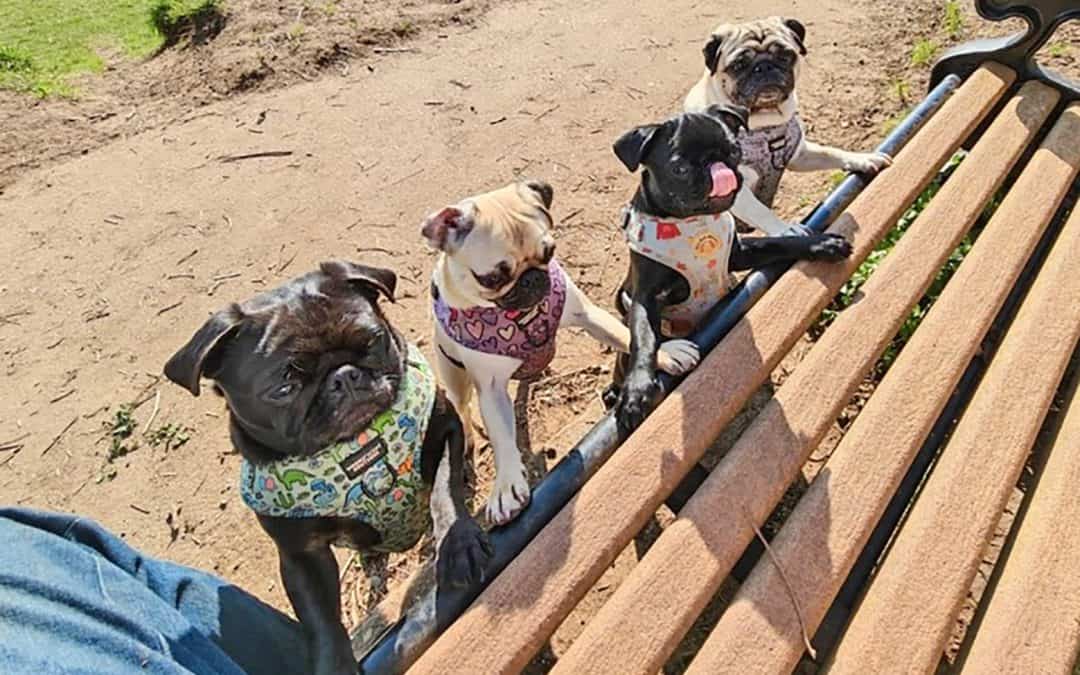
by Yasmin | 7 Aug, 2025 | Blog, Fundraising
Emma raises funds for the PDWRA as part of her company’s Volunteer Week!
Over the past year, I’ve had the privilege of taking part in a few volunteer initiatives that have been both meaningful and memorable. One of the highlights was volunteering at a high school in New Jersey, where I helped provide interview experience for students preparing to enter the workforce. It was incredibly rewarding to support young people at such a pivotal moment in their lives and help boost their confidence as they navigate their first professional steps.
I also took part in a fantastic global initiative called Be My Eyes, a platform that connects volunteers with blind and partially sighted individuals who need assistance with everyday tasks. One particularly touching moment was helping a blind father choose the colour of icing for his daughter’s birthday cupcakes. A small act on the surface, but incredibly meaningful to be part of that celebration in even the tiniest way.
Through this initiative, I was able to convert my volunteer hours into donation points, which my company then matched as part of our annual volunteer drive. This is something we do every year, and it brings out a great sense of community (and a bit of healthy competition!) between departments to see who can log the most volunteers!
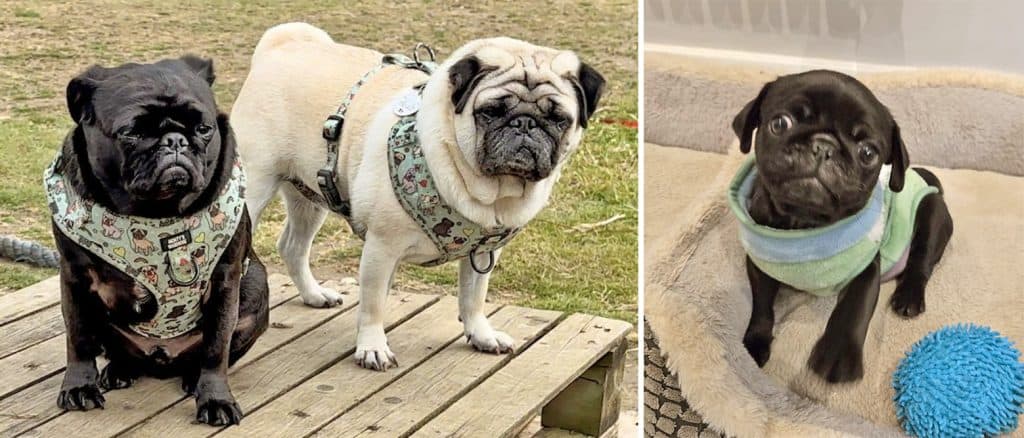
On a more personal note, life outside of work revolves heavily around our four pugs: Ernie (our ‘chonky boy’), Murphy (a lovable troubled soul), Winnie (who’s more cat than dog) and Spike (who we often say should’ve been named Dennis – as in the Menace). They are the centre of our world.
In fact, we recently made a big move from Kent to Lincolnshire, with them at the heart of that decision, as we wanted more space and a better quality of life for them. Ernie and Winnie came from a wonderful, registered breeder, who remains very involved in their lives to this day. Murphy and Spike, on the other hand, are both rescues with rough beginnings but hearts of gold.
Murphy was rescued from a drug den and took time to settle, but he’s now deeply loved. Spike, the runt of his litter, was heartbreakingly going to be abandoned by a backyard ‘greeder’ just a week before Christmas. As the saying goes, ‘One man’s rubbish is another man’s treasure’ and those two are certainly treasures in our home. Whether it’s volunteering in the community or making sure our dogs have the best life possible, giving back, whether to people or pugs, is something we really believe in.
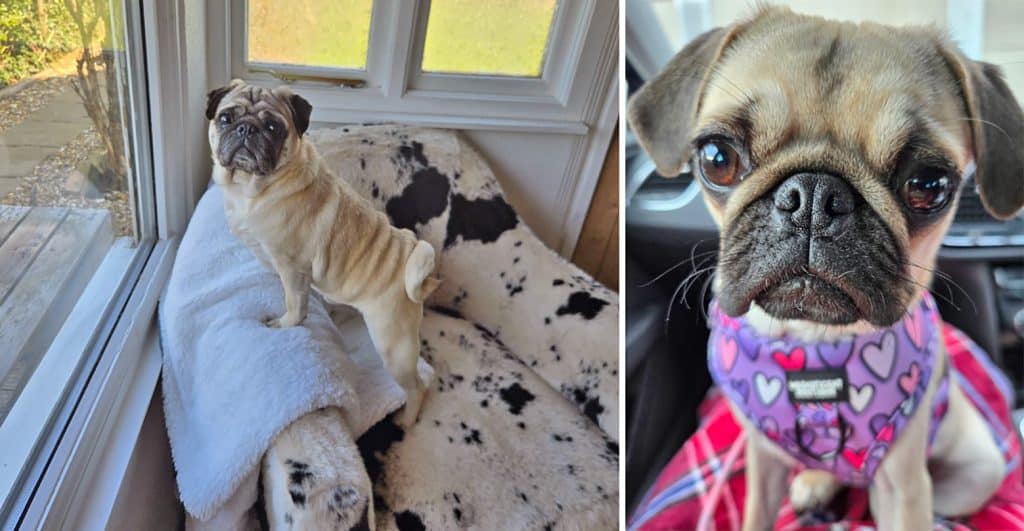
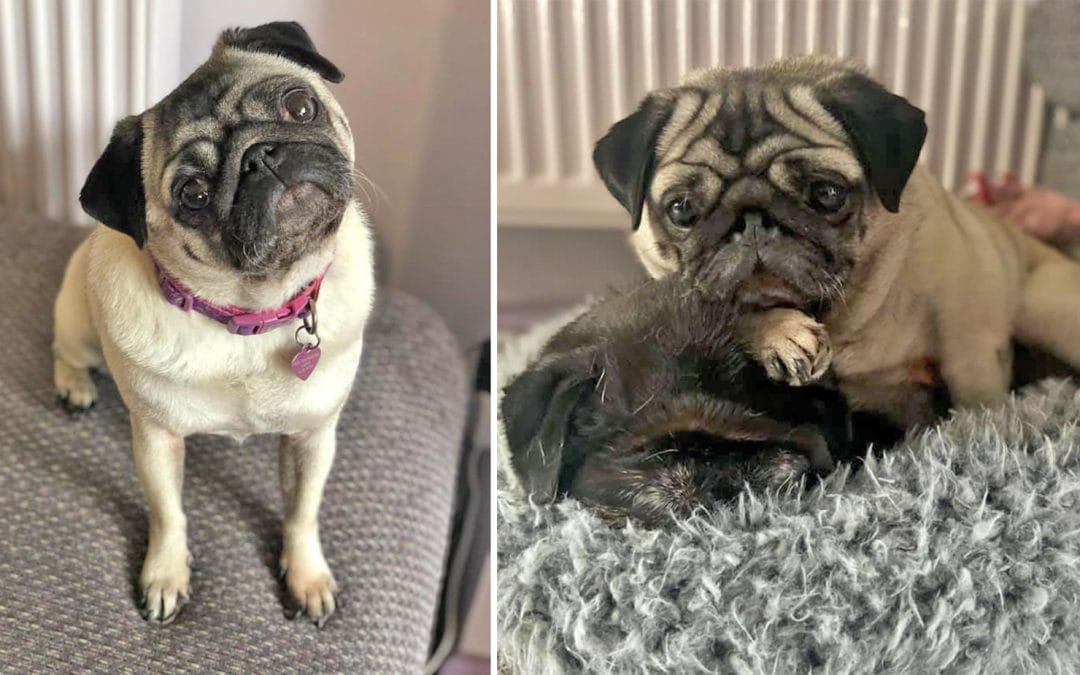
by Yasmin | 7 Aug, 2025 | Blog, In Memoriam
The life and times of Little Lottie, aka Crazy Girl, aka Stinky Minky.
It was the 23rd of August 2018 when I pulled into an Asda car park in Newmarket to collect “the goods”, aka Lottie, an approximately 3–5-year-old fawn pug. She was my second pug adopted from the PDWRA, and I had driven halfway between my house and her foster’s house to collect her. At this point, I had a 4-year-old fawn boy called Branston, and a 10-year-old black boy, Archie, who was my first PDWRA pug, whom I adopted 2 years prior. I was ready for a girl, and 3 is the magic number after all, but I wasn’t quite prepared for how unique and absolutely bonkers Lottie was.
I first noticed on the way home that she just would not lie down like a normal dog. She was on my lap (don’t worry; I wasn’t driving), with her blanket, but she kept pushing back on her front legs and lifting her head up. I realised later that this was the beginning stance for her classic ‘back drop’ move, which happened whenever in the arms of someone capable of rubbing her belly – which it turned out she was practically addicted to.
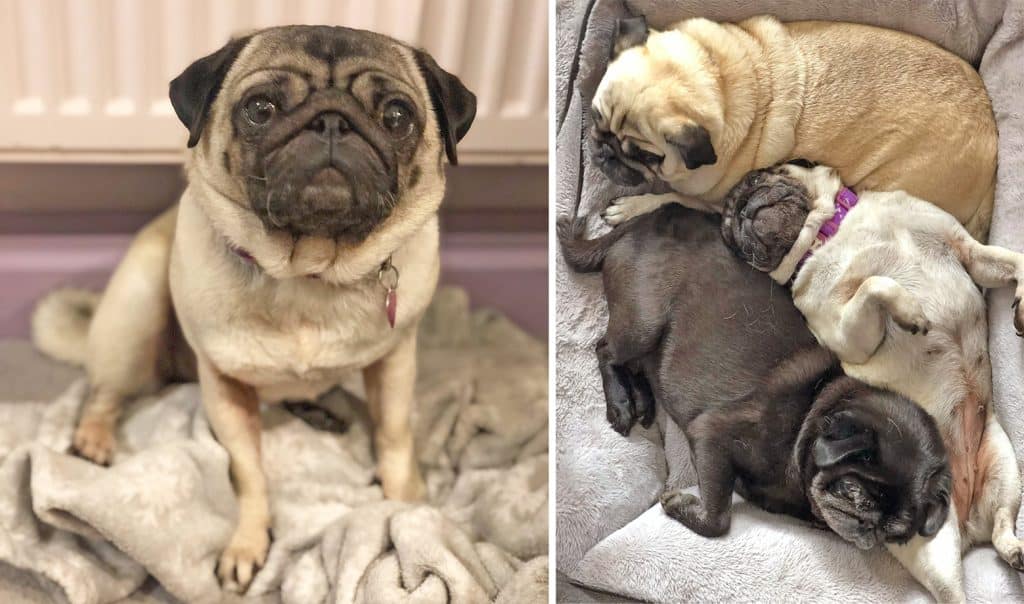
Lottie settled in fine with the boys. She was getting lots of attention from Archie, and I later ended up calling her his ‘sister-wife’ as they were obsessed with licking each other. Archie was especially partial to chewing- or gumming- on Lottie’s ears.
Despite settling in well, it wasn’t long before Lottie’s past caught up with her in terms of her health. On her first day with me, she had stitches from her spay and BOAS surgeries and was completely bald from her chin all the way down to the underside of her tail, and on most of her feet because of demodectic mange. Her claws were thick and overgrown, and she was missing a couple of toes. When I adopted Archie, the extent of his health problems were bad teeth and an ulcerated nose crease, so it was quite a shock to realise just how much the girls suffer after having been bred. I quickly noticed that Lottie’s eyesight wasn’t the best, which turned out to be advanced pigmentary keratitis, and she spun around like the Tasmanian devil whenever she was excited – this could have been from being crated for most of her life, or potentially some brain damage from lack of oxygen during labour, something we would later decide was the most likely (for all her cuteness she didn’t have the most powerful brain) but it was the onset of her recurrent UTIs that really became her biggest hurdle.
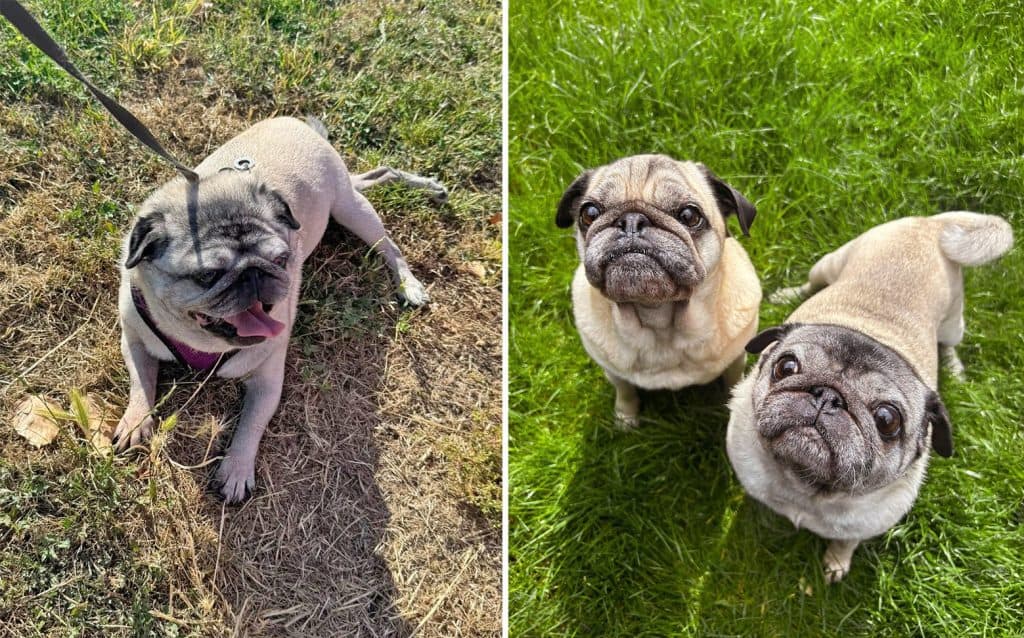
She had investigations done after nothing seemed to clear her UTI’s up, and it was concluded that in her short life, being bred and not cared for properly meant that her bladder wall had thickened, and her urethral sphincter was weak. A bucket load of medications and specialist food later though – and she was cured. Hurrah!
This is when we had a few great years with a bouncy, super fluffy, mad as a box of frogs Lottie. She struggled in the cold weather with her front foot that was missing a toe, but nothing that inventive boot manufacture couldn’t solve. She even managed to learn a couple of tricks, one of which was running and jumping into my arms using my slightly bent legs as a springboard. She had incredible speed, and her back legs were built like a sprinter, she definitely had a tush on her!
In the later years of her life, some of the problems of the past came back. A couple of years after losing Archie to cancer in 2021, Lottie started getting a little bit wobbly in her back legs, the once sprinter and thick-legged girl was now stumbling. It didn’t stop her though, even when she started leaving poopy nuggets around the house (which she had no idea she was doing!).
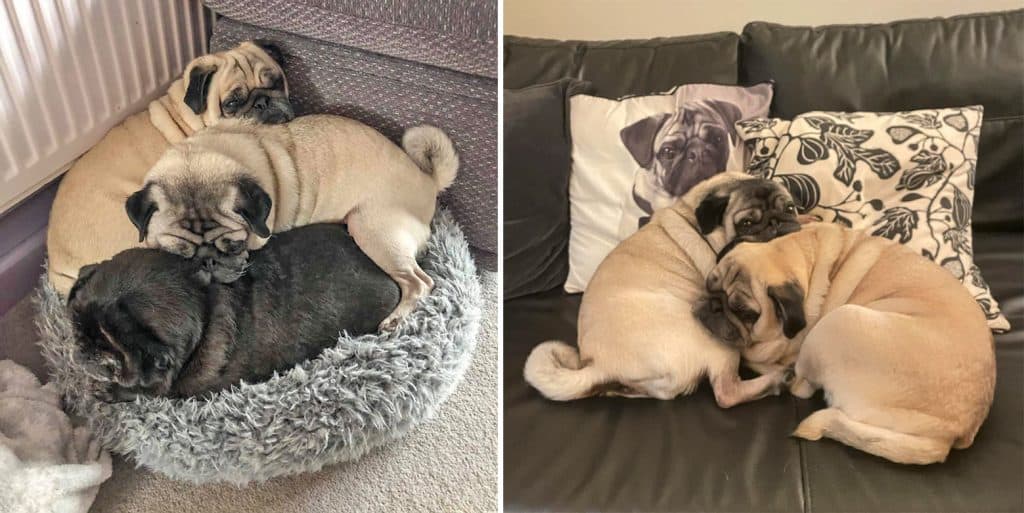
The pug myelopathy took its toll though, and despite absolutely loving her pram walks and sniffing the air, she became doubly incontinent in 2024, which started with another UTI, her first in years. But as Lottie had the privilege of almost complete ignorance, she was still happy as Larry, so we began expressing her bladder, and even though the UTI took a long time to clear up and at one point we thought it might never go away, it cleared up and we carried on in this routine for a whole year with no more bladder issues. (She did have a spell of colitis, which I’ll spare the details of, but as you can probably imagine, an incontinent pug who drags her legs and spins in circles and has NO idea she is doing it was… an experience. My partner now has PooTSD.)
In the last six months of Lottie’s life, she slowly deteriorated. She developed another UTI, just over a year after her last, and her breathing became very bad. She seemed to be less ‘with it’, and after trying a few different medications, we decided it was time to unite her with Archie and send the crazy girl over the rainbow bridge. We don’t know how old she was, probably around 12 or 13, so after nearly seven years with us, she won the hearts of everyone with her quirky and bonkers personality, and often quite baffling habits. Branston is back to being an only pug, which I’m sure he is fine with, as neither Archie nor Lottie ever wanted to chew on his ears anyway!
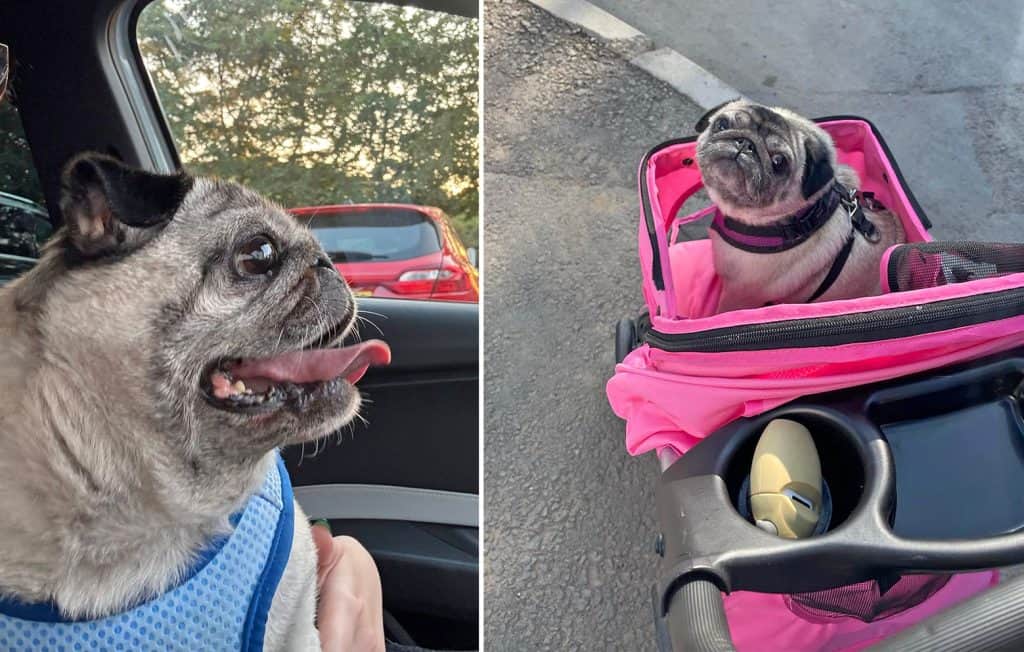
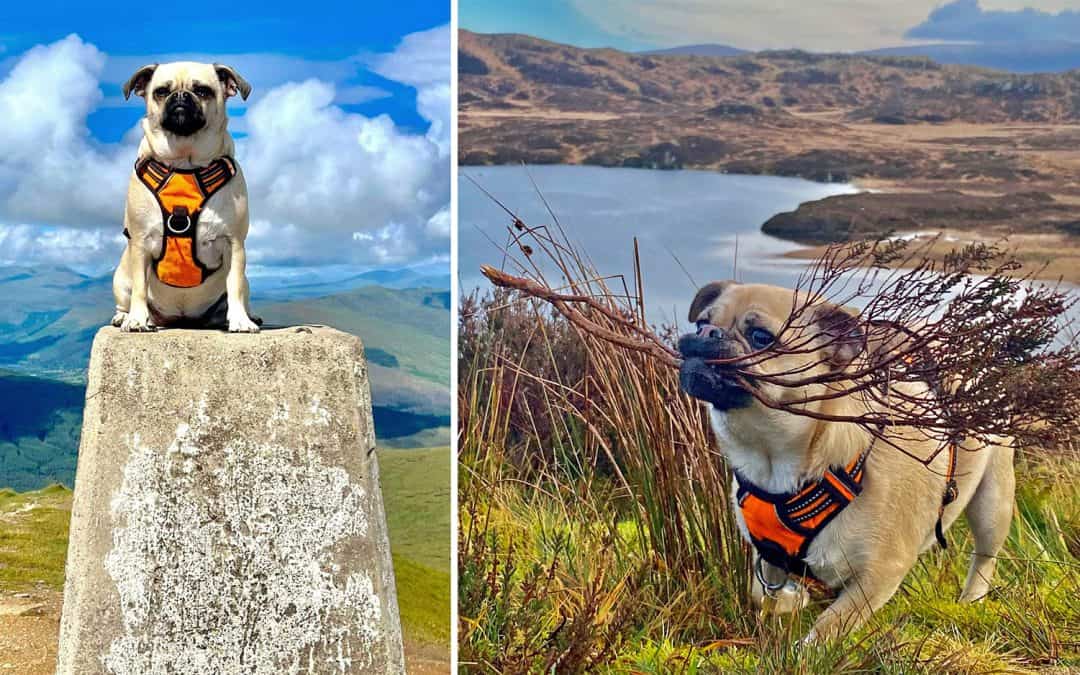
by Yasmin | 7 Aug, 2025 | Blog, Rescue Stories
How did you first hear about the PDWRA?
We hadn’t heard of the PDWRA until a few years ago, they had a stall at a dog show raising funds.
How did you come to make the decision to adopt through the PDWRA?
We contacted several charities hoping to adopt a small dog in need of a loving home. Many charities stated we had to be within a 45 minute drive of the rehoming centres, the PDWRA website did not state this on the request form, so we got in touch.
When did you adopt Soks?
We adopted Soks when she was 8 weeks old, in September 2022.
What made you decide to adopt?
Our daughter and her dog moved home, the house felt empty without them. We were searching for a small dog that required re-homing and would enjoy walks.
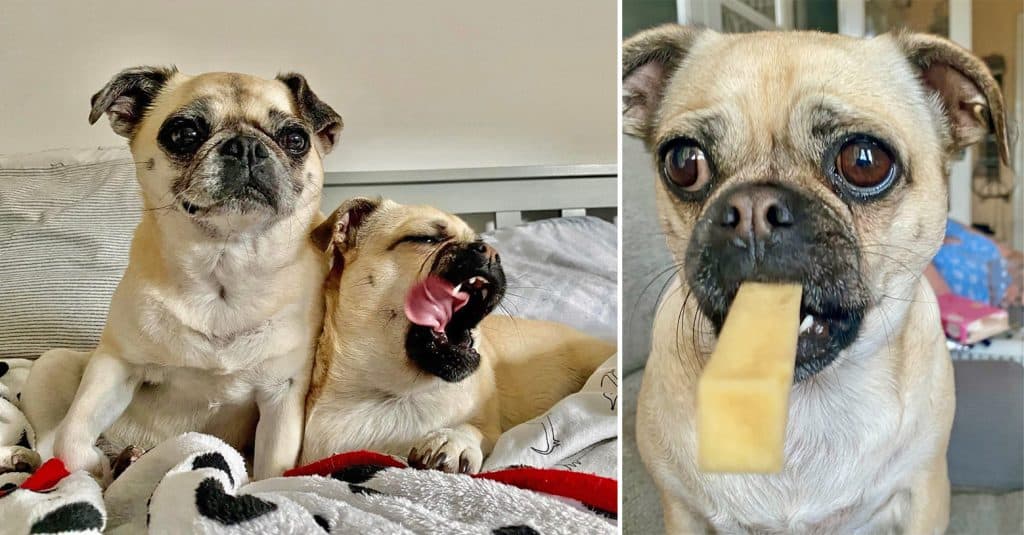
Can you tell us a little bit about Soks?
Soks is a female Chug. Her mother is a pug and her father Chihuahua. Sok’s mother was taken in and homed by a PDWRA foster carer, at the time they were unaware that she was expecting 4 puppies. Soks had a temporary name of ‘Gloria’ due to all the puppies being named after ‘Madagascar’ characters and Soks having the rear end of a hippo! Her name was instantly changed once adopted to Soks, due to her white paws. She has an underbite that turns into a huge smile when she’s happy and a menacing grin when mischievous. She loves everyone, is extremely sociable with humans and other dogs, and well known locally to all that have met her. She often spends holidays with Mia the Chug and adores playing on the beach and running in the sea. Every evening before going to bed she goes into the garden, looks up at the neighbour’s windows and barks, waiting for them to waive goodnight to her. Her favourite TV programme is ‘The Dog House’ on Channel 4!
How did you find the adoption process?
We filled out the online form to adopt or foster, had an online interview that required us to give a brief tour of our home, then we waited (dogs were still in demand due to COVID 19). We received a phone call asking if we would consider adopting a puppy as we’d requested an older dog. From there, we visited the foster carers home to meet the puppies, Soks chose us, and we returned to collect her when she turned 8 weeks old. The process was easy, with ample support and guidance (Huge thank you to all the foster carers and all involved with PDWRA).
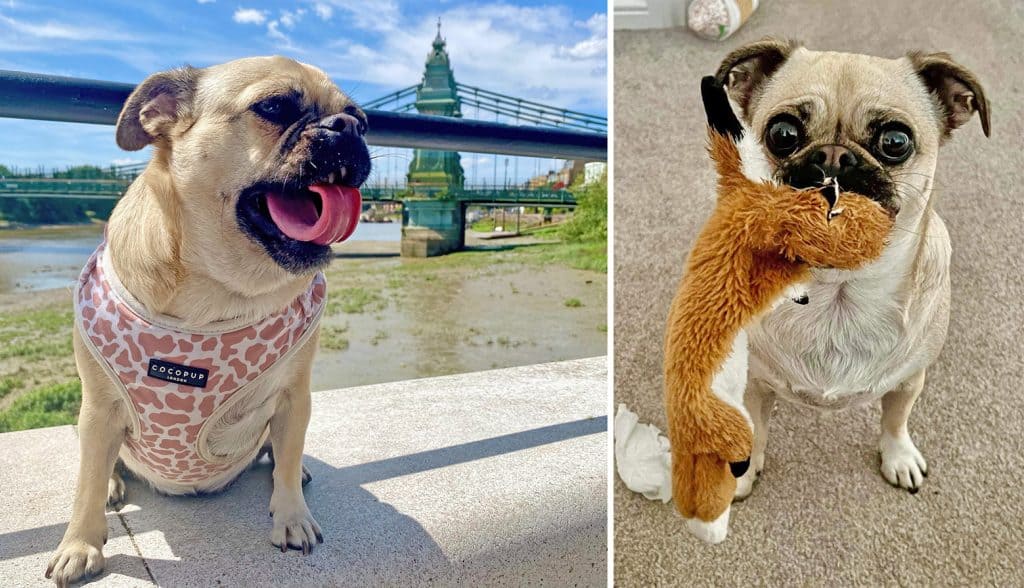
Anything you think prospective adoptive or foster parents should know?
If taking on a puppy, be prepared for sleepless nights and a hive of activity, followed by short naps and mischievous behaviour. We were extremely lucky that Soks required very little to no house training. Chugs aren’t lazy and Soks enjoys long walks, socialising with other dogs and daily zoomies. She can recognise all food and social locations that sell pup cups or have gravy bones. Don’t expect a Chug to forget any of these locations, walking pass is not an option!
What has life been like since adopting Soks?
The first 6 months can only be compared to a 2yr old mischievous human baby. The following years encourage you to explore the outdoors, enjoy the snuggles and the love a dog gives, meet other dog owners and give up 70% of your bed, as a chug takes up far more room than a herd of sheep when it comes to having personal space!
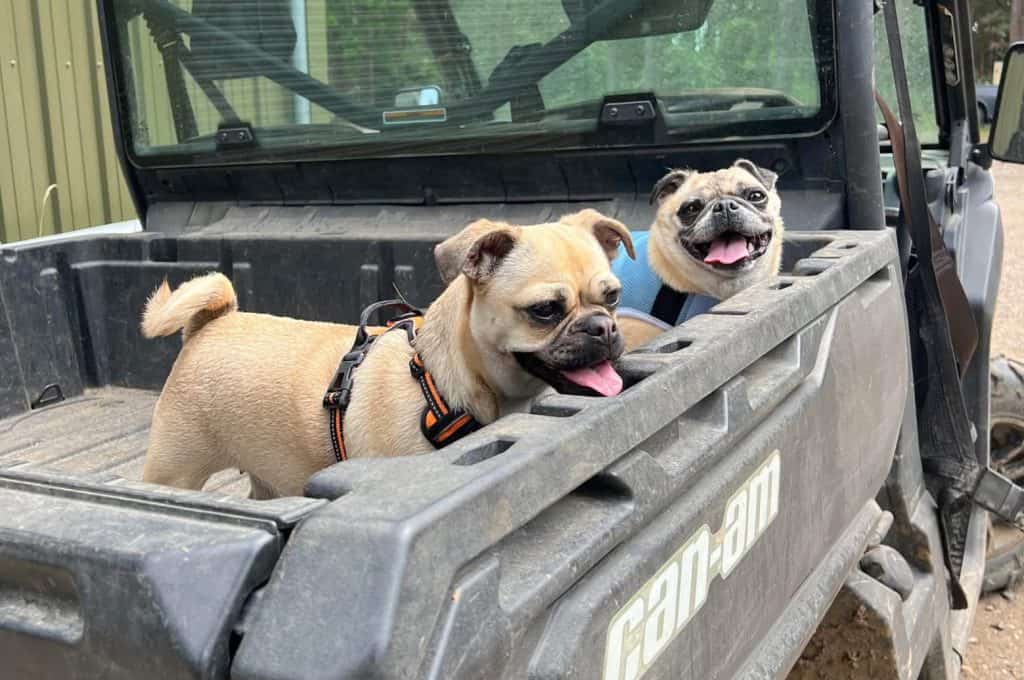
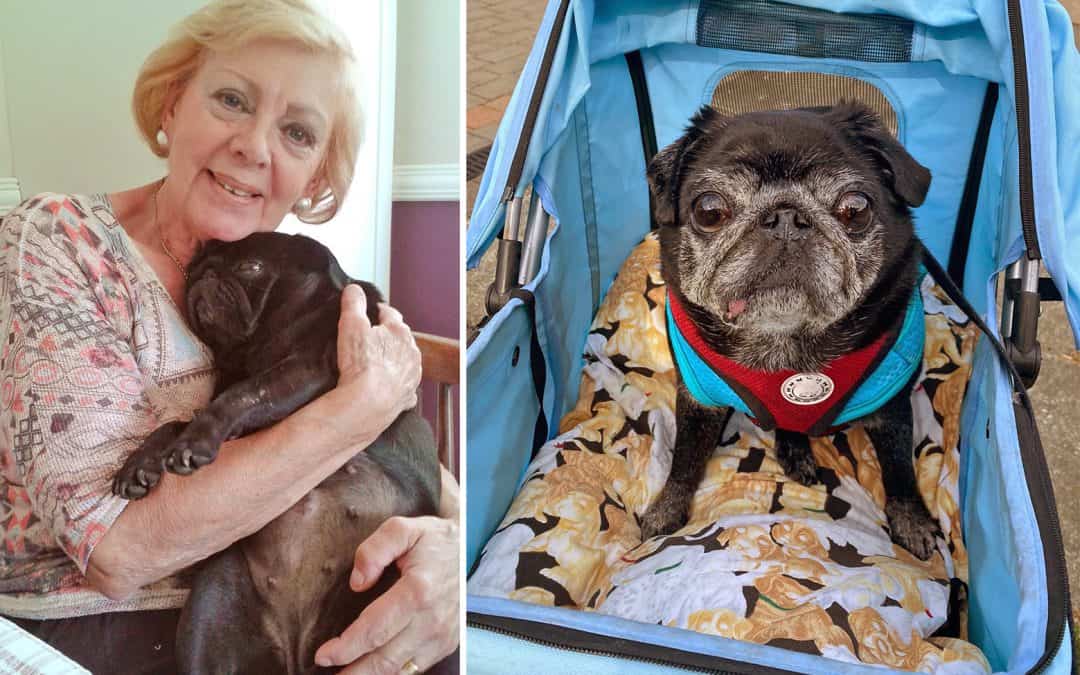
by Yasmin | 6 Aug, 2025 | Blog, Rescue Stories
In April’s newsletter you may have read the article about Laura & her pug Ethel and how her pug story began 40 years ago. Well following on from that, as Laura is my daughter, here is my story of how I discovered Pug Welfare and my pug journey.
Having bought from a breeder, our first pug Honey in 1984, during a chance meeting while out on a dog walk with Honey a fellow pug owner told me about PDWRA and the annual Pug Days at Crowhurst. We sadly lost Honey in 1994 and after her loss we decided to go down the rescue route as PDWRA seemed such a great organisation to adopt through. Over the past 30 + years I have had the pleasure of adopting :- Hanky Panky, Millie, Lily, Mabel and finally, our precious Black Betty, who has been with us for the past 10 years.
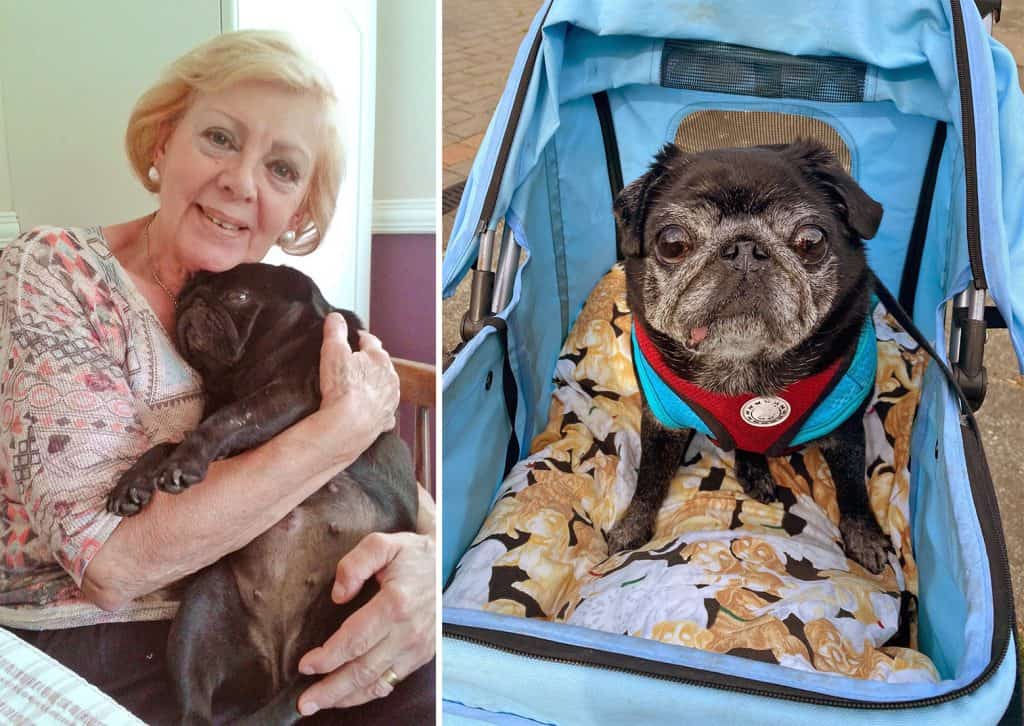
I found the process of adopting through PDWRA quite straight forward and it became easier for us as time went by, after each adoption we didn’t have to wait too long to receive a call from Pug Welfare with our next adoptee. Over the years, all our girls were taken to almost every Welfare Day at Crowhurst from 1987 until 2016, when sadly they became no more. They were a great day out, games for the pugs, raffles and various different stalls, plus the much loved auction to raise money for pug welfare. Another not to be missed PDWRA occasion were the Pug Tea Parties that were held once or twice a year during the summer months, the pugs and the humans always had a great time!!
The pugs I have adopted have always enjoyed a holiday away with us, over the years they have been to Yorkshire, Norfolk, down to Devon and to West Sussex, and nearer to us on the Kent coast. I must say, although the girls have always enjoyed a change of scenery, running on the sand – definitely not in the water! or enjoying a new walk and smells in the Countryside, they always loved getting home, back into their comfort zone! This goes especially for Betty, she’s a real home pug and loves her daily routine.
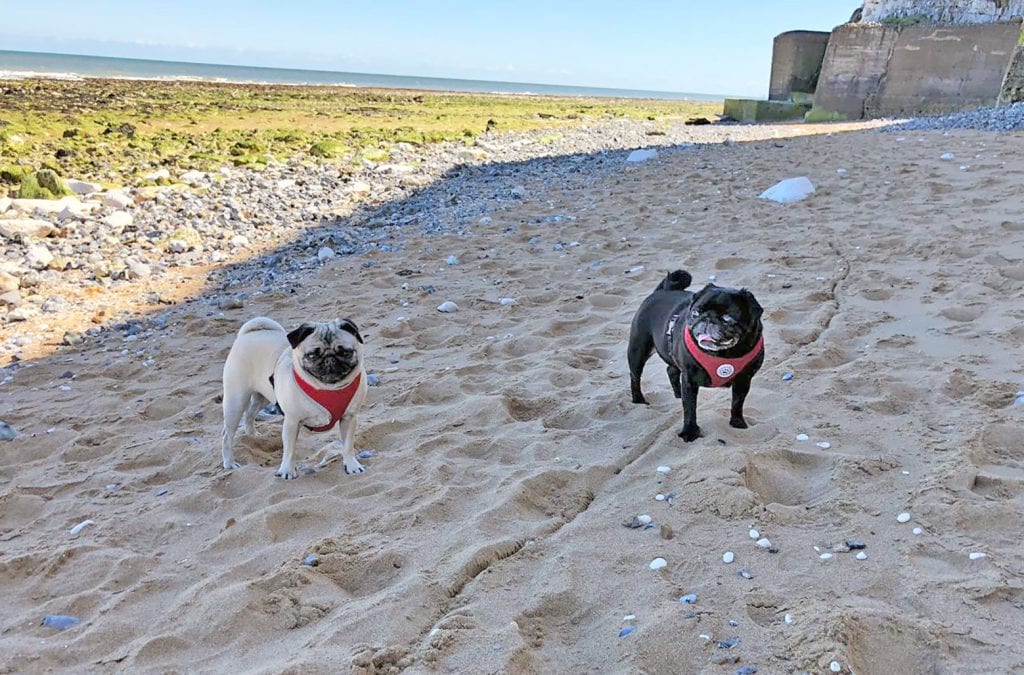
We adopted Betty in 2015, she was a little over 5 years old and my most vivid memory of her is arriving at 2pm on the 26thMarch. Judi and Andrew pulled onto the drive and out jumped the prettiest, bright eyed little black pug, who promptly breezed into our lives as much to say “well I’m here”! She had a quick look around, made sure she had no opposition and everything met with her standards and approval, checked out the garden, christened the grass and decided she’d stay!!!
Betty has been a joy to have in our lives, as an elderly lady now she has become even more feisty and stubborn, aging ladies do have that privilege. Her sight is not so good now and Betty has arthritis in her back, but she copes well with her eye drops and her regular injections at the vets and she still retains the loveable character she has always been blessed with. Due to Betty’s advanced years, she has just celebrated her 15th Birthday, her favourite pastimes now are eating, sniffing lampposts, barking at anything and sleeping, in any particular order!!
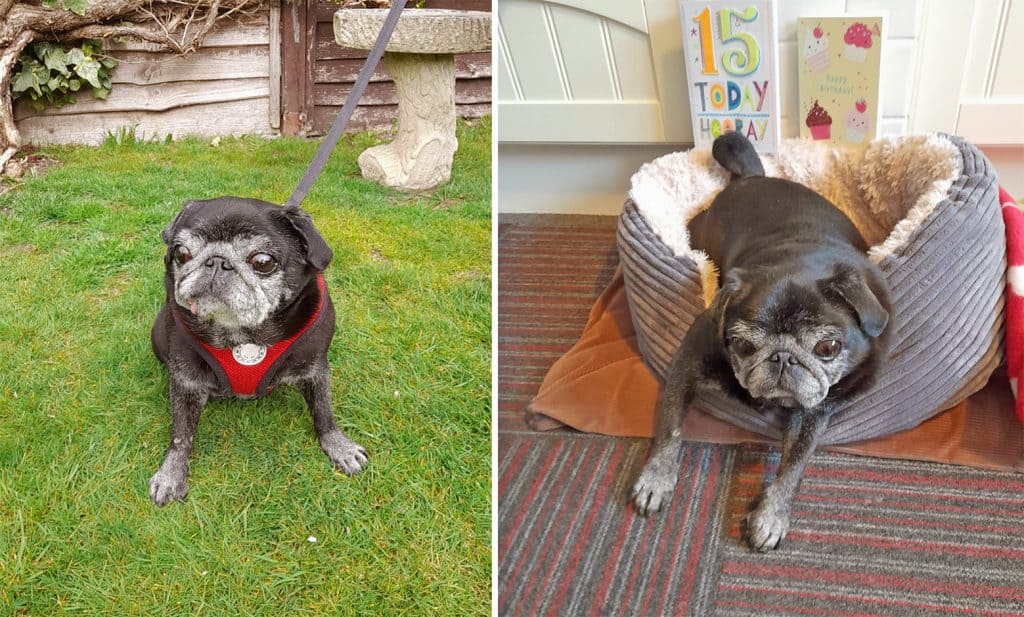
Obviously over the past 40 years there have been ups and downs with looking after a pug, the sheer overwhelming sadness when one of the girls have passed away, but such happiness when a new little pug arrives, full of enthusiasm to start a new life in their forever home.
If I was ever asked “would I pursue the adoption route again after over 30 years?”, I would answer a resounding yes in a heartbeat. Young, middle years or an oldie, each pug brings their own character and rewards you with love and the trust they give you, is such a beautiful thing.
I feel so grateful to have shared such a large part of Betty’s life, and parts of all the other girls who have gone before, and also my 35 years of being part of such a wonderful pug charity. Plus, the added assurance that you are always able to contact PDWRA if you need any medical advice or support, the members are always there to help and advise.
Hopefully PDWRA will continue their brilliant work rehoming our lovely breed for another 50+ years!
*****
If you could provide a forever home by adopting a pug in need, please see latest details for applications at:
https://pugwelfare-rescue.org.uk/adopting-a-pug/
If you would alternatively like to help a pug along its journey by fostering, please see:
https://pugwelfare-rescue.org.uk/fostering-a-pug/


















